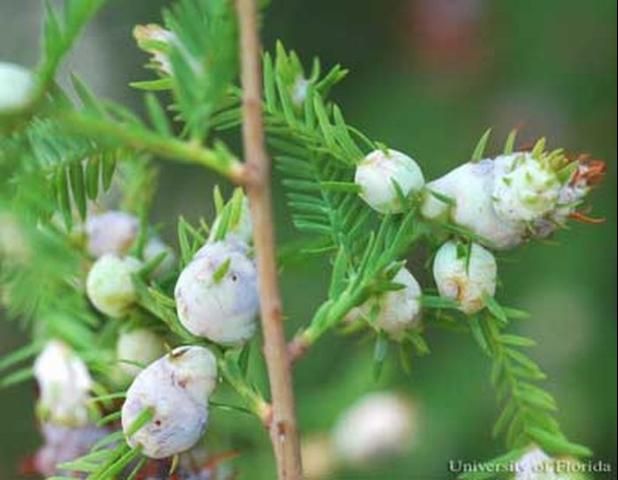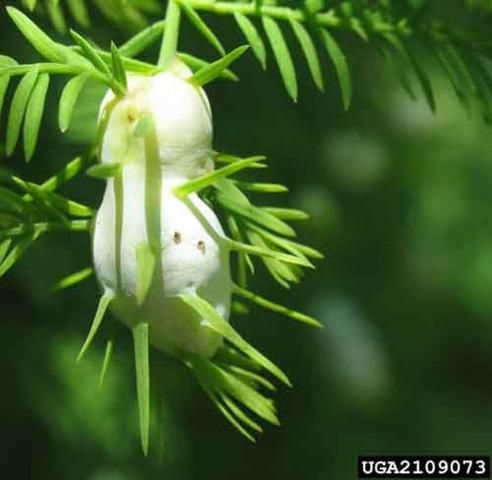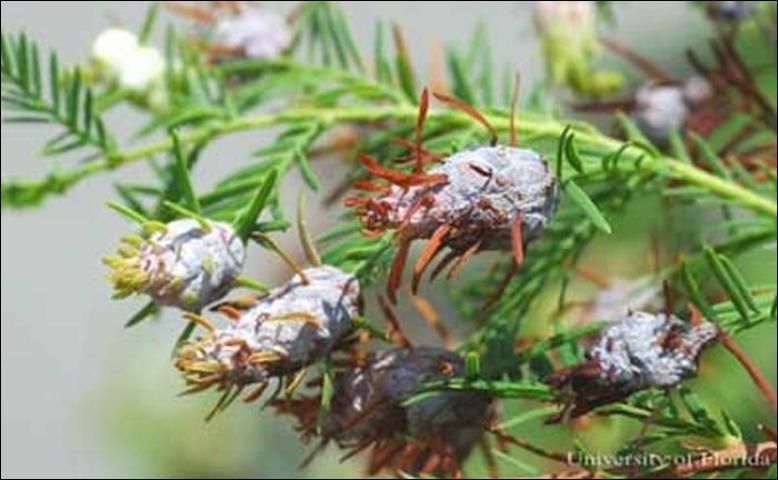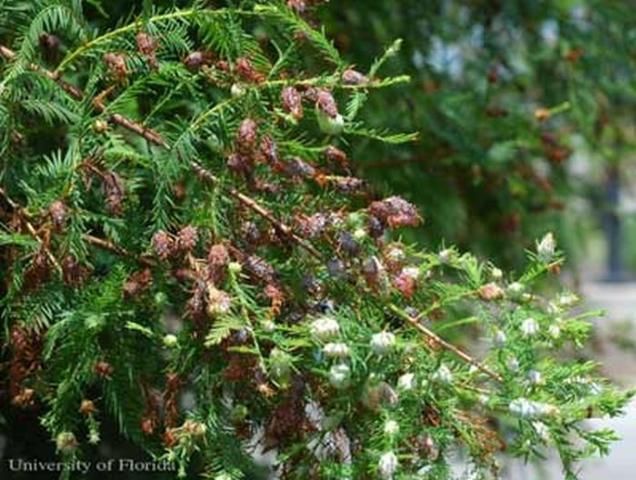The Featured Creatures collection provides in-depth profiles of insects, nematodes, arachnids and other organisms relevant to Florida. These profiles are intended for the use of interested laypersons with some knowledge of biology as well as academic audiences.
Introduction
The cypress twig gall midge, Taxodiomyia cupressiananassa (Osten Sacken), attacks bald cypress (Taxodium distichum) and pond cypress (T. ascendens), inducing galls that develop from leaf bud tissue which negatively affect the appearance of these ornamental trees.

Credit: Russel F. Mizell, III, University of Florida
Distribution
This midge is found in the midsection of the U.S. from north Illinois, Indiana to Florida and west to Louisiana, Tennessee, and Alabama.
Description
Adults
The adults are tiny flies with hyaline wings covered with short setae. The thorax and appendages of males are tan and the abdomen is tan-orange. The abdomen of the female is orange-red. Males and females are approximately 1.57 and 2.17 mm long, respectively.
Eggs
The eggs are bright orange, translucent, about 0.6 mm long by 0.08 mm wide, and average 15 eggs per cluster.
Larvae
The larvae when newly hatched are light orange, about 0.6 mm long by 0.09 mm wide. At this point the sternal spatula is not visible but becomes visible as larvae mature, it then changes color to orange-red and reaches about 1.5 mm long by 0.072 mm wide.
Pupae
The pupae are obtect (wings and appendages are appressed to the body ) and bright orange. Males and females are approximately 1.53 mm and 1.84 mm long, respectively.
The oval shaped galls are formed on the terminal portion of the branchlets. When mature they resemble miniature pineapples that look like elongate swellings on the leaflets. The color varies from pink at first, turning light green as development progresses. However, the galls appear white most of the time because of a covering of fine, powdery material. When adults emerge the galls turn brown. Overwintering galls are usually copper-brown, dropping with branchlets in late autumn. The galls average 20 mm in length, but larger galls may reach 3 cm in length and 2 cm in width and may contain an average of 16 larvae. The number of midge larvae inside is highly correlated with the length of the gall. The gall tissue is spongy and succulent but becomes less succulent as the midge larvae mature.

Credit: Albert Mayfield, Florida Department of Agriculture and Consumer Services, Bugwood.org
Life Cycle and Biology
The life cycle of T. cupressiananassa is univoltine in the northern U.S. and bivoltine (two generations) in northern Florida.
The flies overwinter as larvae on the ground in the fallen galls in early November and pupate in mid-April inside the galls.
Adults flies emerge in mid-May for an extended period of time. Nearly 95% of the adult midges emerge within three weeks of the onset of emergence. Copulation occurs the same day as adult emergence. After mating, the female midge flies to the leaves where it oviposits on the new developing foliage an average of 120 eggs during their one to two day life span.
The midge larvae induce gall formation by the leaflets initiating as pink swellings of the branchlets at the feeding sites. Galls rapidly increase in size during the first three weeks and at the same time, larvae gradually move toward the longitudinal axis of the gall where each larva makes a small chamber which it occupies. Before pupation, the larvae reverse their position so that their heads point toward the gall surface.
For adult emergence, the pupa moves through the larval chamber and breaks the gall surface until its head and thorax are completely outside. The second generation feeds until mid-September and in late October the galls and foliage fall from the trees.
Hosts
Bald cypress (Taxodium distichum) and pond cypress (T. ascendens) are the only hosts recorded for this insect.
Damage
It appears that some genetic lines of cypress are less susceptible to the gall midge than others. Apparently, the galls do not appreciably harm tree health. However, the appearance of cypress, a commonly planted ornamental, is made unsightly by the brown galls. Also, gall-infested branches droop due to the weight of the numerous galls.

Credit: Russel F. Mizell, III, University of Florida

Credit: Russel F. Mizell, III, University of Florida
Management
Collect and destroy fallen galls in autumn or in early spring before the midges become active and start laying eggs. This reduces the number of galls in a new season.
Insecticide applications are not recommended because high populations are often regulated by natural enemies that emerge at the same time as the midges such as the following parasitoids:
- Tridymus sp. (Hymenoptera: Pteromalidae), which attacks the first instar just before it becomes imbedded in the gall tissue. This is the dominant species in the T. cupressiananassa parasitoid complex.
- Aprostocetus fidius Girault (Hymenoptera: Eulophidae)
- Tetrastichus sp. (Hymenoptera: Eulophidae), which attacks young larvae in developing galls.
- Inostemma sp. (Hymenoptera: Platygasteridae), which attacks the egg or newly hatched midge larva.
- Platygaster virginiensis (Ashmead) (Hymenoptera: Platygasteridae)
Selected References
Bennett P, et al. (2006). Buckeye Yard and Garden Online newsletter. Buckeye Yard and Garden Online. https://bygl.osu.edu/ (29 June 2012).
Chen C, Appleby J. 1984. Biology of the cypress twig gall midge, Taxodiomyia cupressiananassa (Diptera: Cecidomyiidae), in central Illinois. Annals of the Entomological Society of America 77: 203-207.
Hodges A, Buss E, Mizell RF III. 2006. Insect Galls of Florida. UF/IFAS. SP 343.
Terrel C. (2005). Plant health care report 11:5. The Morton Arboretum. https://mortonarb.org (3 October 2022).